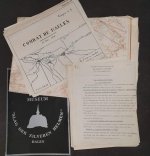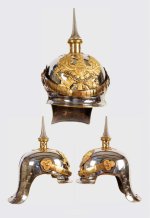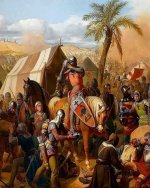You are using an out of date browser. It may not display this or other websites correctly.
You should upgrade or use an alternative browser.
You should upgrade or use an alternative browser.
Today 12th August 1914. Commemoration.
- Thread starter Khukri
- Start date
Eichenblatt
Active member
But what a fascinating topic....Also; 12th of August 1099; the commemoration of the victory Ascalon.
By Godfried van Bouillon.
But that might be a bit off topic.... ;-)
Battle of Askalon - a land battle that took place on 12 August 1099 between the Crusaders and the Fatimid army coming to the relief of besieged Jerusalem. It is often regarded as the last battle of the First Crusade.
The Fatimid grand vizier Al-Afdal, in June 1099, on hearing that the siege of Jerusalem by the armies of the First Crusade had begun, began organising an army at Askalon to strike a relief for Jerusalem. The army's camp was probably on the north-eastern side of Askalon. The main force was transported by sea from the Sinai Peninsula, where it did not arrive until around 4 August. By this time Jerusalem had already been conquered by the Christians.
Having achieved the main objective of the crusade and taken the city, the leaders of the expedition proclaimed Gotfrid of Bouillon as the new ruler of Jerusalem. However, he refused to accept the title of king and, at his request, was granted the title of Defender of the Holy Sepulchre (Latin: Advocatus Sancti Sepulchri). Shortly after assuming power, an Egyptian envoy came to Gotfried with a demand to leave Palestine immediately. After a firm refusal, news of the approach of the Egyptian army under the personal command of the vizier Al-Afdal reached Jerusalem. Gotfrid hastily assembled troops and sent messengers to Tancred and his brother Eustace of Boulogne asking them to obtain information about the enemy's movements. The two barons headed towards Ar-Ramli, on the way taking several Egyptian scouts captive, from whom they gained information about the numbers and location of the Muslim army. They also learned that Al-Afdal was currently waiting for a fleet with additional supplies and was not expecting an attack by the Crusaders. They sent a message to Gotfrid urging him to march. The ruler of Jerusalem gathered his own forces and then asked the other crusade leaders to join the expedition. Robert of Flanders immediately joined his army, and a little later also Robert of Normandy and Rajmund of Toulouse - both only after his own scouts had confirmed the situation.
Gotfrid and Robert of Flanders left Jerusalem with their entire army on 9 August and set off for Ar-Ramli, where they joined the forces of Tancred and Eustace. Rajmund and Robert of Flanders also marched out on 10 August. A day later, the entire army assembled at Ibelin. It was also joined by troops from Jerusalem drawn from the general conscription, called up under arms at Gotfried's command. The first contact between the Fatimids and the Crusaders occurred on the evening of 11 August south of the village of Ashdod, when a Crusader patrol captured Arab cattle herders who had been forced to reveal information about the location of the Egyptian army.
The Crusaders took advantage of the element of surprise and, early on the morning of 12 August, attacked the Fatimid army camp by forming a battle formation with the following alignment - Gotfrid on the left wing, Rajmund on the right, and Robert of Normandy, Tankred and Robert of Flanders in the centre. Al-Afdal was taken completely by surprise. He knew of the Crusader army heading towards him, but, misled by his own scouts, he did not realise that the Christians were so close. When the crusaders struck, the Muslims were almost defenceless. For a while the Fatimid cavalry tried to salvage the situation by slowing down the attack to allow some time to organise the infantry formation, but the manoeuvre failed and the defensive line was broken. After several hours of fighting, the Egyptian army dispersed. The left wing of Al-Afdal's army retreated towards the coast, seeking refuge on ships, pursued by the troops of Raimund of Toulouse. The right wing, chased by Gotfrid of Bouillon, fled south. A large Egyptian detachment took refuge in a grove of fig trees, where the Crusaders burned them all alive. Robert of Normandy and Tancred's forces broke into the Fatimid camp, where Robert's bodyguard captured the vizier's flag and many of his personal belongings. Al-Afdal himself fled to Askalon, from where he returned by ship to Egypt.
The Crusaders gained huge booty in the battle. Most of these fell to the troops of Robert of Normandy, whose soldiers captured all the vizier's possessions from his camp. The main consequence of the victory, however, was the consolidation of the Christians' position in the Holy Land and the assumption of control over most of Palestine. For the Fatimids, the defeat in battle proved very painful not only because of the losses, but above all because it derailed the chances of easily regaining Jerusalem and other lands lost to the Crusaders. However, the chance to capture Askalon itself, whose crew was aware that they would not be able to resist a united Crusader army, slipped through Gotfrid's hands. But with the slaughter in Jerusalem in mind, and the fact that only those of the defenders who surrendered to Rajmund survived at the time, the Muslims declared that they would only surrender the city to the Count of Toulouse. However, Gotfrid did not agree to such terms offended by the attitude of Rajmund, who from the beginning of the whole expedition considered himself the most prominent among the crusaders. In turn, the envious behaviour of the ruler of Jerusalem outraged the other crusade leaders, who left his camp. In these circumstances, Gotfrid was forced to abandon the siege of Askalon, as he had too few troops to capture the city without their help.
The Battle of Askalon was the last armed clash of the First Crusade. After this victory, many crusaders returned to Europe. In addition to Gotfrid now ruling Jerusalem, his younger brother Baldwin of Boulogne, who was Count of Edessa, Tankred, who became Duke of Galilee, and Boemund, who ruled in Antioch, remained in the Middle East.
Attachments
John Josef
Well-known member
Also; 12th of August 1099; the commemoration of the victory Ascalon.
By Godfried van Bouillon.
But that might be a bit off topic.... ;-)
I remember me and the misses visited his Castle back when we were still dating and saw a birds of prey show there.
What a fantastic memory I'll will cary for my remaining days.
I'm still in awe of the accomplishments of these great warriors.






